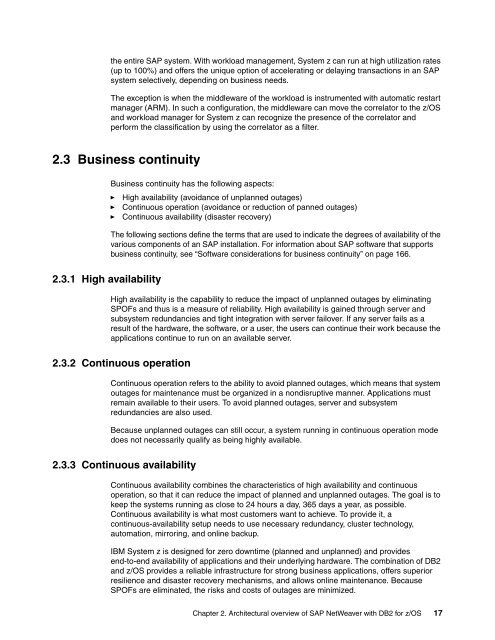Download PDF - IBM Redbooks
Download PDF - IBM Redbooks
Download PDF - IBM Redbooks
You also want an ePaper? Increase the reach of your titles
YUMPU automatically turns print PDFs into web optimized ePapers that Google loves.
the entire SAP system. With workload management, System z can run at high utilization rates<br />
(up to 100%) and offers the unique option of accelerating or delaying transactions in an SAP<br />
system selectively, depending on business needs.<br />
The exception is when the middleware of the workload is instrumented with automatic restart<br />
manager (ARM). In such a configuration, the middleware can move the correlator to the z/OS<br />
and workload manager for System z can recognize the presence of the correlator and<br />
perform the classification by using the correlator as a filter.<br />
2.3 Business continuity<br />
2.3.1 High availability<br />
Business continuity has the following aspects:<br />
► High availability (avoidance of unplanned outages)<br />
► Continuous operation (avoidance or reduction of panned outages)<br />
► Continuous availability (disaster recovery)<br />
The following sections define the terms that are used to indicate the degrees of availability of the<br />
various components of an SAP installation. For information about SAP software that supports<br />
business continuity, see “Software considerations for business continuity” on page 166.<br />
High availability is the capability to reduce the impact of unplanned outages by eliminating<br />
SPOFs and thus is a measure of reliability. High availability is gained through server and<br />
subsystem redundancies and tight integration with server failover. If any server fails as a<br />
result of the hardware, the software, or a user, the users can continue their work because the<br />
applications continue to run on an available server.<br />
2.3.2 Continuous operation<br />
Continuous operation refers to the ability to avoid planned outages, which means that system<br />
outages for maintenance must be organized in a nondisruptive manner. Applications must<br />
remain available to their users. To avoid planned outages, server and subsystem<br />
redundancies are also used.<br />
Because unplanned outages can still occur, a system running in continuous operation mode<br />
does not necessarily qualify as being highly available.<br />
2.3.3 Continuous availability<br />
Continuous availability combines the characteristics of high availability and continuous<br />
operation, so that it can reduce the impact of planned and unplanned outages. The goal is to<br />
keep the systems running as close to 24 hours a day, 365 days a year, as possible.<br />
Continuous availability is what most customers want to achieve. To provide it, a<br />
continuous-availability setup needs to use necessary redundancy, cluster technology,<br />
automation, mirroring, and online backup.<br />
<strong>IBM</strong> System z is designed for zero downtime (planned and unplanned) and provides<br />
end-to-end availability of applications and their underlying hardware. The combination of DB2<br />
and z/OS provides a reliable infrastructure for strong business applications, offers superior<br />
resilience and disaster recovery mechanisms, and allows online maintenance. Because<br />
SPOFs are eliminated, the risks and costs of outages are minimized.<br />
Chapter 2. Architectural overview of SAP NetWeaver with DB2 for z/OS 17

















